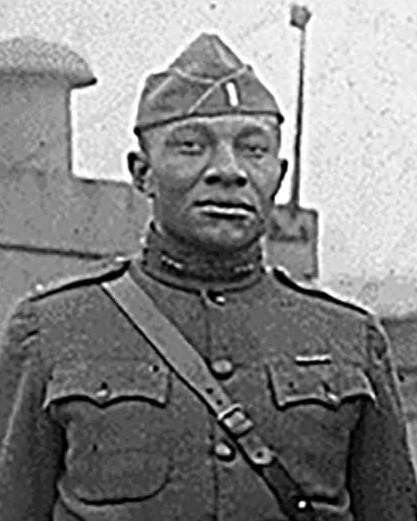Last updated: November 29, 2022
Person
Cleveland Leigh Abbott

National Archives
Cleveland Leigh Abbott was born on December 19, 1894, in Yankton, South Dakota. His parents, Albert and Mollie Abbott, were originally from Alabama and moved to South Dakota in 1890. He grew up in Watertown, South Dakota, and graduated from high school in 1912. After graduating high school, Cleveland attended South Dakota State College in Brookings, South Dakota. Besides being a good student and graduating in four years, he also played football, baseball, basketball, and ran track, earning 14 varsity letters. He graduated from college in 1916 as one of the first African American graduates from a South Dakota college.
After college graduation, he taught at Tuskegee Institute as an agriculture instructor. Around this same time, he married his Jessie Harriet Scott. They had one daughter, Jessie Ellen, who went on to be the first women’s track team coach at Tennessee State University in Nashville, Tennessee.
As the country mobilized for World War 1, Cleveland Abbott joined the U.S. Army. He was assigned to the 366th Infantry Regiment as a lieutenant at Camp Dodge, Iowa. The 366th Infantry was a segregated all-Black regiment. The 366th was formed on August 16, 1917, and assigned to the 92nd Infantry Division. As an all-Black unit, the 92nd was nicknamed the Buffalo Soldiers Division. This was in honor of the original Buffalo Soldiers of the late 1800s.
On June 15, 1918, the 366th departed Hoboken, New Jersey, for the port of Saint Nazaire, France. The 366th saw combat on the Saint Die Sector near Vosges, France. During the night of September 7 and into the early morning of September 8, the Germans attacked the 92nd Division’s lines with a reported 730 mustard-gas shells falling. This was the first and only time the German raiding parties were successful in entering the trenches of the 366th Infantry’s lines. After a brisk firefight, the 366th drove the Germans back to their original positions.
From October 5 until the end of the fighting on November 11, the 366th was assigned the Marbache Sector near Lorraine, France. On November 10, the 366th received orders to attack the German positions because military intelligence reported that the Germans were in full retreat. The men advanced as ordered and took Bois Voivrotte, France, before retreating when the Germans used extensive mustard-gas shells and high explosives on the 366th’s new position.
On November 11, at 11 a.m., the entire front became quiet and calm. The Armistice ending the Great War had taken effect, bringing an end to the bloody and brutal fighting. Abbott and the rest of the 366th remained in Europe with the Army of Occupation until they returned to the United States on February 28, 1919.
After the war, Abbott joined the faculty at Kansas Vocational School in Topeka, Kansas. At the school he served as the commandant of cadets and a coach. In 1923, Abbott returned to Tuskegee Institute, this time as an agricultural chemist and athletic director. As Tuskegee Institute’s athletic director, Abbott also coached the football team from 1923 until 1954. During his time as head coach, the Tuskegee Golden Tigers had a record of 202 wins, 97 losses, and 27 ties. They had six undefeated seasons during his tenure. In 1937, Abbott started Tuskegee’s women’s track and field program. That team was undefeated from 1937 to 1942. The track and field team included six women who later participated in the Olympics, including gold medalists Alice Coachman and Mildred McDaniel.
Cleveland Leigh Abbott died on April 14, 1955, at the Veterans Hospital in Tuskegee. He was buried in the Tuskegee University Campus Cemetery at Tuskegee, Alabama.
